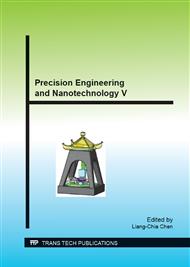p.262
p.267
p.274
p.282
p.288
p.297
p.305
p.310
p.316
Wireless Driving of Electrostatic Film Actuator by Pre-Charging Electrodes with DC High Voltages
Abstract:
Electrostatic film actuator is a thin, lightweight and flexible actuator composed of two plastic films with fine-pitched electrodes embedded in them. In this paper, we report a novel driving method for the actuator, in which the electrodes in one film (the slider film) are pre-charged with DC high voltages, and the slider film is driven by AC voltages applied to the electrodes in the other film (the stator film). Typically, the actuator has been driven by applying three-phase AC voltages to the electrodes in both films; in the driving method, the slider film required connections of feeding wires, whose tensions causing disturbance to its motion. The advantage of the pre-charging method is that the slider film is free from the feeding wires; in turn, it requires an additional step before driving: charging of the slider electrodes. To confirm the feasibility of the method, experiments were conducted using a pair of films fabricated by flexible printed circuit technology. Each of the films incorporate 475 strips of electrodes within their overlapping area; the electrodes are 18 mm in length and 40 μm in width, arranged at a constant pitch of 160 μm. DC voltages used for pre-charging the three-phase electrodes in the slider were 500 V, -500V and 0 V, respectively. After the pre-charging, 500 V three-phase voltage applied to the stator drove the slider with maximum thrust force of approximately 120 mN. We also found that the thrust force of the actuator decay with time after pre-charging, which indicate that further investigations are necessary to prolong its duration.
Info:
Periodical:
Pages:
288-293
Citation:
Online since:
August 2014
Authors:
Price:
Сopyright:
© 2015 Trans Tech Publications Ltd. All Rights Reserved
Share:
Citation:


